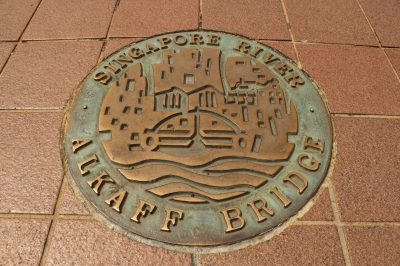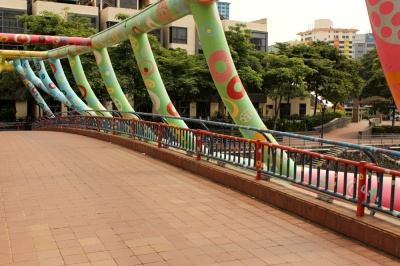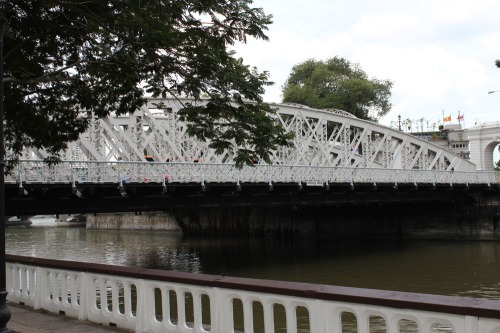Singapore River
Singapore River by local poet, Lee Tzu Pheng
designed to give new life
to the old lady.
We have clearned out
Her arteries, removed
detritus and slit,
created a by-pass
for the old blood.
Now you can hardly tell
her history.
We have become
so health-conscious
the heart
can sometimes be troublesome.
Lee Tzu Pheng (Dr) (b. 13 May 1946, Singapore -) is considered one of Singapore’s most distinguished poets. A retired university lecturer, she is an award-winning poet who has published in anthologies and journals internationally. All her three volumes of poetry, Prospect of a Drowning (1980), Against the Next Wave (1988) and The Brink of an Amen (1991), have won the National Book Development Council of Singapore (NBDCS) Award – From http://infopedia.nl.sg/articles/SIP_447_2005-01-25.html
Sculpture “The River Merchants”
 This sculpture signifies a Scotsman- Alexandra Laurie Johnston who was a prominent merchant, former ship’s owner/captain, Businessman, Magistrate, Justice of Peace in early years of Singapore.
This sculpture signifies a Scotsman- Alexandra Laurie Johnston who was a prominent merchant, former ship’s owner/captain, Businessman, Magistrate, Justice of Peace in early years of Singapore.
 The sculpture shows he was mediating between Chinese trader and Malay chief while Indian and Chinese coolies load sacks onto a bullock cart.
The sculpture shows he was mediating between Chinese trader and Malay chief while Indian and Chinese coolies load sacks onto a bullock cart.
 This is a common sight around the river in those days.
This is a common sight around the river in those days.
 The sculpture locates between Singapore River and Maybank Towers where the heart of the river flow day and night.
The sculpture locates between Singapore River and Maybank Towers where the heart of the river flow day and night.
Please drop by listen to their conversation, at the same time enjoy the breeze of the riverbank.
The skulls, The rats, The centipedes and The Singapore River.
In the early years when mangroves swamps and human skulls were covered long ago before the Thomas Raffles came.

During the Raffles colony, Colonel Farquhar asked the Sea Gypsies who were the early communities, “Whose are all these skulls and dead bodies?” they replies, “They belongs to the men who were robbed at sea and slaughtered here.”
According to Munshi Abdullah wrote; there was a plague of rats in the river community, the size of rats were as huge as cats.
Colonel Farquhar rewarded 1 ‘wang’ for every rat been caught. Hence, thousands of rats brought in every morning. After 6 or 7 days, multitude of creatures were still can be founded. He increased the paid out to 5 ‘duit’ for each catch. But still, thousands of rats have been brought in everyday.

Subsequently, Farquhar ordered to dig a deep trench to bury those dead bodies.
The number of rats brought in dwindled until 10 or 20 rats a day.
Not long after, centipedes struck. A number of centipedes attacked people who living on the riverbank. Again, Colonel Farquhar offered 1 ‘Wang’ for every brought in. Hundreds of catches been brought in everyday, until the number descended to 20 or 30 centipedes for 2 or 3 days. Finally, the cleaning up campaign came to the end.

Did you ever stopped by and wonder who is calling at the riverbank of Singapore River? The water? The leaf? Or the flow of reminiscences?

A tale of Orang Laut and Singapore River
 According to legend based on the history of pre-Rafflesian time of Singapore, Orang Laut or Sea Gypsies was the communities who lived ‘in the numerous bays, inlets ad creeks surrounding Singapore.’
According to legend based on the history of pre-Rafflesian time of Singapore, Orang Laut or Sea Gypsies was the communities who lived ‘in the numerous bays, inlets ad creeks surrounding Singapore.’
Half of them lived on water, in little canoes that could scarcely stretch themselves. The water lodgings were equipped with 1 or 2 cooking pots, earthy jars and mats made of pandanus leaves that allowed shading from sun and rain.

They spent most of their time on boat, where birth, marriage and death took place therein. As they were accustomed to life on the boat, they are easily recognized with their wadding gait on land.
The other half of these people lived in huts on the banks near Kallang River and at the wider portion of Singapore River.
During the times of British settlement, Major-General William Farquhar (1774-1839), the First Resident and Commandant of Singapore was appalled by the Orang Laut wearing no clothes, so he distributed money, clothes and rice to them. Their children were terrified by the newcomers, merchants, laborers from all over the world.
One even jumped into the sea and got drowned when people approached near their boats.
And now, if you attempted to jump into the water, hoping to stay closer to the legendary tale, I think that is the only best reason I could agree upon.
53) Circles of rainbow on the Bridge
Welcome to Alkaff Bridge, you are strolling on a rainbow now.
The Alkaff Bridge is a pedestrian Bridge spanning across the Singapore River in length 55m, height 35m. As the name suggested, it is related to the nearby Alkaff Quay. Alkaffs is also a wealthy Arab family who settled in Singapore during the early 20th century.
One side is connected to the “River Place” condominium.
The other side is connected to “The Quayside” condominium. What a home sweet home for these estate residents!
This bridge resembles a wooden boat (Tong Kang) is a gift from a lady artist, Pacita Abad (1946-2004) who transformed it to a rainbow bridge with an artist touch of joy and vibrant colors!
She used 120 liters for white base paint after scraping the old paint away. And subsequently, using 630 liters for two coats of 6 base colors for this Art piece.
And finally, applying 2,350 circle stencils, using 46 colors painted with hands. In addition to these, the railings are also full of wonderful circles.
Imagine staying in a home next to the rainbow friend…
Or a ferryboat passing by here and there outside your doorstep, what else do you ask for…?
51) Throw up your New Year resolutions

Who dare to “Bungy” your New Year resolution in this way?

Get ready! And wish you all the best!

Smoke gets in your eyes!

One more time for stage effect!

And let’s go and let it go!

Up, up to the sky! (1st bounce)

Up, up swing, can’t hear your scream! (2nd bounce)

Down.. down again, hear you now! (3rd bounce)

Did you regret it or you like the thrills and spills? (4th bounce)

Come for Reverse Bungy in Singapore.

At the bank of Singapore River in Clark Quay, forget about the muddy water and the gloomy sky.
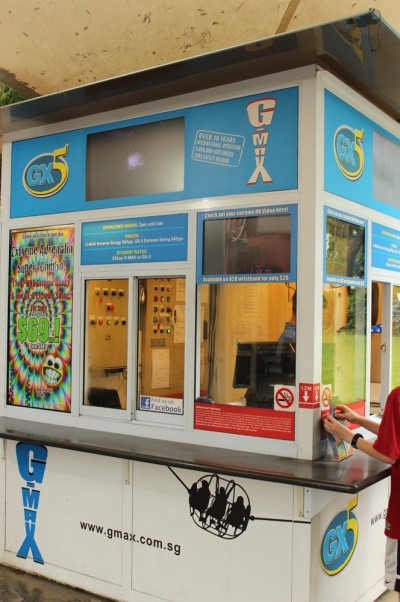
It is near the colorful MICA building, you can also follow the sound of people screaming to find it.
Make your reservations at this cart and make your resolution in the air!
40) The two arms of The Fullerton Hotel

In my opinion, The Fullerton Hotel, from the direction of Victoria Theatre is a giant man standing in between two spreading arms with a warm cheering face!

Cavenagh Bridge, the right arm was built in 1870. It is the oldest bridge existing in its original form on Singapore River. It named after the last India-appointed Governor of the Straits Settlement, Major General William Orfeur Cavenagh.
The bridge was designed by John Turnbull Thomson, under supervision of Captain Charles Edward Faber, the Madras Engineer who have Mount Faber named after him.
Before the bridge was born, there was one shaky bridge connected the both sides. Travelers just need to pay 1 cent for passing the bridge.

And now, Cavenagh Bridge is one of the Singapore bridges fav by lovers, after it overtook by Anderson Bridge due to overloading problem.

Steel rivets stand still throughout the era.

Anderson Bridge, the left arm was built in 1910. Given a name after the Governor of the Straits Settlement and High Commissioner for the Federated Malay States, Sir John Anderson.
This beautiful steel arc shape structure was built intended to lighten the load of Cavenagh Bridge. It is so far the last bridge built in steel along the Singapore River.

In the past, there is a belief that men and women tossing apples and oranges respectively into the River will be blessed with a happy marriage.
And for singles hurling oranges into the River will be blessed with a partner soon.
Not so sure if this belief is still concurrence, but the reverse effect may end you getting a fine for littering the River.

The Fullerton Hotel, glimpsed through steel arches and ribs.
14) Where is your Tunnel of Memories?

If you asked around the locals about this pedestrian tunnel, they will concur with a smile of contentment. This is a well-known pedestrian tunnel connecting Queen Elizabeth Walk (Esplanade Park) to Empress Place. Apart from crossing over on the Fullerton Road that leads to Anderson Bridge, this is a leisure way to enjoy the beauty of the Singapore River. In the past, it’s a park where families spent their weekend on. Couples holding hands, dress up like super stars in their bell-bottom pants meet up in the park. Gone were those days, where happy couples, groups of youngsters, families with kids gathered around on weekend in this memorable park of pride. It leaves good memories in most children in the 60s/70s.
On top of the tunnel is Anderson Bridge, a famous local landmark visited by countless.
The concrete parapet wall remains the same standing under the rain and sun unlike the landscape of Esplanade Park that has changed tremendously.

It is quite amazing to see those trees still standing green and lavish while those who once saw them were long gone…
This is my tunnel of memories, where is yours?
39) 2 sculptures by the bridge

On the left of the Cavenagh Bridge, along the fringe of the Singapore River, there are 5 bronze naked boys frolicking, driving off the bridge for a swim.
This First Generation sculpture halted the movement of olden days kids playing along the river while the river is still polluted by mud and garbage. It is a common sight during those days where children swing on trees and take plunge into the river, an uncommon sight these days.
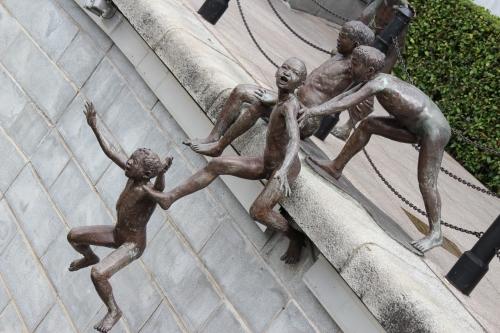
Sculptor, Chong Fah Cheong designed this lovely piece depicting scenes of early days Singapore. You can see the scene played out all over Asia, though the young laughter of the boys were heard no more.

On the right corner of the bridge, a family of Singapura Cat rest themselves there. Kitty mama watches over her 2 lovely kittens frisking happily by the side, though 1 of her kittens was stolen.



